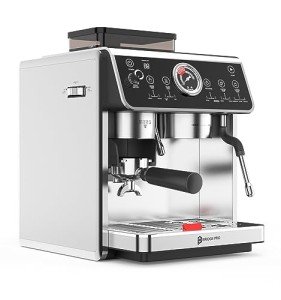10 No-Fuss Methods For Figuring Out Your Home Use Espresso Machines

Home Use Espresso Machines: A Comprehensive Guide
Espresso machines have become a staple in numerous homes as coffee enthusiasts seek to reproduce café-quality brews in the comfort of their kitchen areas. The rise in appeal has led to a varied market filled with different models, functions, and prices. Portable Espresso Machines intends to provide a helpful introduction of home use espresso machines, assisting readers navigate their alternatives effectively.
Comprehending Espresso Machines
Espresso machines work by requiring hot water through finely-ground coffee under high pressure, resulting in a concentrated coffee beverage called espresso. There are numerous kinds of espresso machines classified based on their developing methods and level of automation. The most typical types consist of:
- Manual Espresso Machines: These require the user to control the pressure and water flow, permitting a more hands-on coffee-making experience.
- Semi-Automatic Espresso Machines: These offer automatic control over water pressure, while the user manually grinds and tamps the coffee.
- Automatic Espresso Machines: With the push of a button, these machines immediately control the circulation of water, making it much easier to brew espresso with constant results.
- Super-Automatic Espresso Machines: These all-in-one machines deal with grinding, tampering, brewing, and even milk frothing, making them perfect for users searching for convenience.
- Capsule or Pod Machines: These use pre-packaged coffee pods to create espresso with minimal effort, however they limit choice in developing techniques and flavors.
Table: Comparison of Espresso Machine Types
| Type | Control Level | Relieve of Use | Cleaning Level | Suitable For |
|---|---|---|---|---|
| Manual | User-controlled | Moderate | High | Coffee perfectionists |
| Semi-Automatic | Partial automation | Moderate | Moderate | Home baristas |
| Automatic | Totally automated | Easy | Low | Hectic individuals |
| Super-Automatic | Totally automated | Really simple | Extremely low | Convenience applicants |
| Capsule/Pod | Totally automated | Extremely easy | Very low | Casual drinkers |
Key Features to Consider
When choosing a home use espresso machine, it's essential to consider numerous functions that can substantially impact the quality of espresso and user experience.
- Pressure: Look for machines that offer a minimum of 9 bars of pressure, as this is thought about optimum for brewing espresso.
- Boiler Systems: Single vs. dual boiler systems figure out temperature level stability and the ability to brew espresso and steam milk concurrently.
- Grinder: Integrated mills allow for newly ground coffee, which improves flavor. Think about machines with adjustable grind settings.
- Milk Frother: For those who take pleasure in coffees and lattes, an integrated steam wand or automatic frother is vital.
- Size and Design: Consider your cooking area area and visual choices. Machines can be found in numerous sizes, from compact to big setups.
- Cost: Home espresso machines can vary from a couple of hundred to several thousand dollars, so it's crucial to develop a budget before checking out options.
Advantages and disadvantages of Home Use Espresso Machines
| Pros | Cons |
|---|---|
| Benefit of developing coffee in the house | Initial financial investment can be high |
| Quality of espresso is frequently superior | Requires some skill, specifically with manual machines |
| Capability to try out flavors | Upkeep and cleaning can be labor-intensive |
| Can save money in the long run | Not all machines will match every coffee preference |
Maintenance and Cleaning Tips
Preserving an espresso machine is vital for lengthening its life and guaranteeing constant brew quality. Here are some beneficial tips:
- Regular Descaling: Minerals from water can develop up in the machine. Descale every 1-3 months, depending on water firmness.
- Daily Cleaning: Rinse portafilters, baskets, and steam wands after each use to prevent coffee oils from developing residue.
- Use Filtered Water: This can assist decrease mineral accumulation and enhance the taste of coffee.
- Replace Gaskets and Seals: These elements may wear out gradually and needs to be replaced to keep pressure and efficiency.
- Check out the Manual: Each machine has specific care directions; following these will ensure durability.
FAQs About Home Use Espresso Machines
Q1: What is the very best budget espresso machine?The best budget espresso machine frequently depends on specific needs, but models like the DeLonghi EC155 or the Breville Bambino are popular amongst users for providing fantastic worth. Q2: How long do home espresso machines usually last?With appropriate upkeep, home espresso machines can last anywhere from 5 to 15 years, depending on the quality of the machine and frequency of use. Q3: Can I make cappuccinos and lattes with any espresso machine?While most espresso machines can make coffees and lattes, having a trusted
steam wand or frother is essential for attaining the ideal milk texture.
Q4: Are super-automatic machines worth the investment?For those who prioritize convenience and fast developing, super-automatic machines can be worth the financial investment, though they may lack some customizability in brew strength and flavor. Q5: What kinds of coffee beans are best for espresso?While individual choice plays a function, beans labeled as" espresso "blends are typically roasted darker, producing abundant flavors and a velvety texture when brewed.
Purchasing a home espresso machine can transform the everyday coffee routine into something unique, elevating home brews to café quality. By understanding the different types of machines, crucial features to consider, upkeep needs, and weighing the
benefits and drawbacks, consumers can make informed choices that suit their private choices. As sell continues to grow, no matter the option, every brew can be a scrumptious experience waiting to be appreciated.

